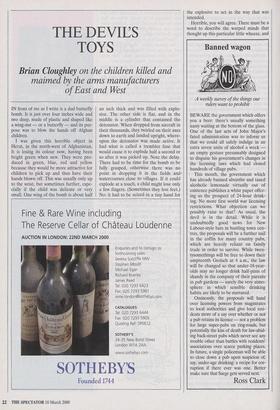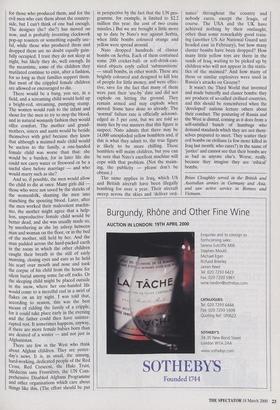THE DEVILS TOYS
Brian Cloughley on the children killed and
maimed by the arms manufacturers of East and West
IN front of me as I write is a dud butterfly bomb. It is just over four inches wide and two deep, made of plastic and shaped like a wing-nut — or a butterfly — and its pur- pose was to blow the hands off Afghan children.
I was given this horrible object in Herat, in the north-west of Afghanistan. It is losing its colour now, having been bright green when new. They were pro- duced in green, blue, red and yellow because they would be more attractive for children to pick up and thus have their hands blown off. This was usually only up to the wrist, but sometimes further, espe- cially if the child was delicate or very small. One wing of the bomb is about half an inch thick and was filled with explo- sive. The other side is flat, and in the middle is a cylinder that contained the detonator. When dropped from aircraft in their thousands, they twirled on their axes down to earth and landed upright, where- upon the detonator was made active. It had what is called a trembler fuse that would cause it to explode half a second or so after it was picked up. Note the delay. There had to be time for the bomb to be fully grasped, otherwise there was no point in dropping it in the fields and watercourses close to villages. If it could explode at a touch, a child might lose only a few fingers. (Sometimes they lost feet.) No: it had to be seized in a tiny hand for the explosive to act in the way that was intended.
Horrible, you will agree. There must be a word to describe the warped minds that thought up this particular little wheeze, and for those who produced them, and for the evil men who cast them about the country- side, but 1 can't think of one bad enough. The designer (he? she?) has moved on now, and is probably inventing clockwork pop-up toasters or something equally use- ful, while those who produced them and dropped them are no doubt equally gain- fully occupied. I trust they do not sleep at night, but likely they do, well enough. In the meantime, some of the children they mutilated continue to exist, after a fashion, for so long as their families support them. But most of the crippled female children are allowed or encouraged to die.
There would be a bang, you see, in a field, and a screaming child would hold up a bright-red, streaming, pumping stump. The women would rush to the infant and shout for the men to try to stop the blood, and in natural womanly fashion they would offer comfort. The mother and grand- mothers, sisters and aunts would be beside themselves with grief because they knew that although a maimed male child would be useless to the family, a one-handed female child was worse than that: she would be a burden, for in later life she could not carry water or firewood or be a useful slave before marriage — and who would marry such as she? And so, if possible, the men would allow the child to die at once. Many girls did those who were not saved by the shrieks of the womenfolk, shaming the men into stanching the spouting blood. Later, after the men worked their malevolent machis- mo, the mother might agree that a help- less, unproductive female child would be better dead, and she was usually made so, by smothering as she lay asleep between man and woman on the floor, or in the bed of the mother, still held by her. And the man padded across the hard-packed earth in the room in which the other children caught their breath in the still of early morning, closing eyes and ears as he held his scarf over mouth and nose and took the corpse of his child from the house for silent burial among some far-off rocks. Or the sleeping child might be placed outside in the snow, where her one-handed life would come to a merciful end in a swirl of flakes on an icy night. I was told that, according to season, this was the best means of ridding the family of a cripple, for it could take place early in the evening and the father could then have uninter- rupted rest. It sometimes happens, anyway, if there are more female babies born than are desired of a winter — and not just in Afghanistan. There are few in the West who think about Afghan children. They are yester- day's news. It is, as usual, the unsung, hard-working, dedicated people of the Red Cross, Red Crescent, the Halo Trust, Medecins sans Frontieres, the UN Com- prehensive Disabled Afghans Programme and other organisations which care about things like this. (The effort should be put in perspective by the fact that the UN pro- gramme, for example, is limited to $2.2 million this year: the cost of two cruise missiles.) But we are brought a little more up to date by Nato's war against Serbia, when little bombs coloured orange and yellow were spread around.
Nato dropped hundreds of cluster bombs on Serbia. Each of them contained some 200 cricket-ball- or soft-drink-can- sized objects coyly called `submunitions' — small bombs, in other words. These are brightly coloured and designed to kill lots of people for little money, and were effec- tive, save for the fact that many of them were past their 'use-by' date and did not explode on hitting the ground. They remain armed and may explode when moved. Some have done so already. The `normal' failure rate is officially acknowl- edged as 5 per cent, but we are told so many lies by our masters that this figure is suspect. Nato admits that there may be 14,000 unexploded yellow bomblets and, if this is what they admit to, the true figure is likely to be more chilling. These bomblets will maim children, but you can be sure that Nato's excellent machine will cope with that problem. (Not the maim- ing, the publicity — please don't be obtuse.)
The same applies in Iraq, which US and British aircraft have been illegally bombing for over a year. Their aircraft sweep across the skies and 'deliver ord-
nance' throughout the country and nobody cares, except the Iraqis, of course. The USA and the UK have achieved nothing by their onslaught, other than some remarkably good train- ing (another US Air National Guard unit headed east in February), but how many cluster bombs have been dropped? How many little yellow toys are there in the sands of Iraq, waiting to be picked up by children who will not appear in the statis- tics of the maimed? And how many of these or similar explosives were used in Russia's attacks on Grozny?
It wasn't the Third World that invented and made butterfly and cluster bombs: they are products of so-called civilised countries, and this should be remembered when the 'developed' nations lecture others about their conduct. The posturing of Russia and the West is dismal, coming as it does from a self-satisfied bunch of humbugs who demand standards which they are not them- selves prepared to meet. They scatter their evil bombs on civilians (a few more killed in Iraq last month; who cares?) in the name of `justice' and cannot see that their bombs are as bad as anyone else's. Worse, really, because they imagine they are 'ethical' bombs.
Brian. Cloughley served in the British and Australian armies in Germany and Asia, and saw active service in Borneo and Vietnam.



















































































 Previous page
Previous page